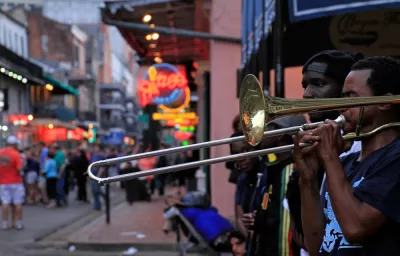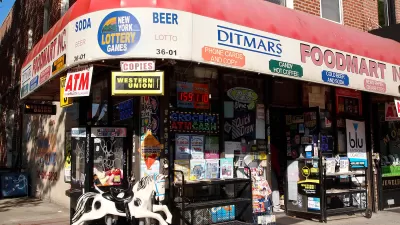Marla Nelson of The University of New Orleans and and Renia Ehrenfeucht of the University of New Mexico, guest blog about a recent article in the Journal of Planning Education and Research.

Cities across and beyond the United States have invested in consumer and lifestyle amenities ranging from bike lanes to brewpubs in the hopes of attracting footloose, educated professionals and bolstering their economies. Acknowledging that a skilled workforce is essential to regional competitiveness and influenced by the idea that creative workers can live wherever they want, amenity-based strategies to recruit creative talent have moved into the mainstream of economic development practice. But are they effective? We explore this question in our recent article in the Journal of Planning Education and Research “Beyond the Jobs versus Amenities Debate: Understanding the Migration of Educated Workers and Implications for Planning.”
We investigate what factors influenced creative professionals' decisions to come to New Orleans after Hurricane Katrina flooded the city in 2005. The city, which had faced a decades long brain drain of young talent, experienced an influx of educated newcomers after Hurricane Katrina, making it an ideal situation to examine why people came and what would influence whether they stayed. For the project we interviewed 78 young and mid-career professionals who moved or returned to New Orleans after Hurricane Katrina and re-interviewed a subset of the original people five years later. The interviewees gave nuanced accounts of their decisions to both move and stay highlighting the complexity of migration decisions. The findings are important for both mid-sized and shrinking cities that are deciding among strategies to attract and retain an educated workforce.
Our findings show that access to jobs matter, supporting the view of migration as a response to economic incentives over amenities. But notably, interview participants were lured to New Orleans by more than the availability of a job or the prospect of a good salary. They were motivated by the possibility of fulfilling work where they could make a difference and be part of something larger. Interviewees emphasized that the recovery environment and the city’s small size created an opportunity to find jobs that gave them authority and aligned with their values, jobs that would not have been available to someone with similar experience in larger labor markets.
While interviewees valued amenities, the amenities did not, however, influence whether they came or intended to stay in New Orleans. Many relocated from large, amenity rich regions and acknowledged that the quality and scope of offerings was better and more extensive in previous places they had lived. What they identified as unique in New Orleans, and what they valued enough to influence their migration decisions, was a local culture that supported public socializing and allowed for a better balance between their personal and professional lives. The work-life balance and public culture together with the city’s compactness and relative affordability made consumer and cultural amenities more easily accessible. And importantly, they enabled respondents to easily build and maintain close friendships and a broader network of casual relationships. It was these relationships and the ways in which they maintained them that enhanced their connectedness to the community and attachment to the city.
Yet many interviewees also expressed ambivalence about the decision to stay. They recognized that while the city provided ample opportunities for young and mid-career professionals, long-term opportunities were limited, and they might have to choose between career advancement and the everyday life they enjoyed. Interviewees also expressed ambivalence about being the people the city was trying to attract. They did not want to be gentrifiers, but rather people who contributed to rebuilding a better and more just city for everyone.
As cities face decisions about how to invest scarce economic development resources, these interviews suggest that more traditional approaches to economic development that seek to diversify the economy and strengthen regional innovation systems coupled with investments in public schools and public services that benefit a broad range of people are likely to attract and retain early and mid-career residents as much as or more than investments intending to improve their quality of life. To the extent that planners focus on amenities, they need to understand what educated workers value and how they connect to the community, not universal, one-size-fits-all approaches to create hip neighborhoods or grow an art scene. Jobs and amenities matter, but finding meaningful work and living a meaningful life matters more.
Full Article Open Access Until June 14, 2018
Marla Nelson, Ph.D., holds the Freeport Professorship in Urban & Public Affairs. Dr. Nelson is an Associate Professor in the Department of Planning and Urban Studies at the University of New Orleans where she teaches and conducts research in local economic development, community development and urban revitalization.
Renia Ehrenfeucht, Ph.D., is a Professor and the Chair of Community & Regional Planning Department at the University of New Mexico. She investigates shrinking cities, and how both people and institutions respond to population loss. She also researches everyday life and the politics of public space use and design.

Alabama: Trump Terminates Settlements for Black Communities Harmed By Raw Sewage
Trump deemed the landmark civil rights agreement “illegal DEI and environmental justice policy.”

Planetizen Federal Action Tracker
A weekly monitor of how Trump’s orders and actions are impacting planners and planning in America.

Why Should We Subsidize Public Transportation?
Many public transit agencies face financial stress due to rising costs, declining fare revenue, and declining subsidies. Transit advocates must provide a strong business case for increasing public transit funding.

Understanding Road Diets
An explainer from Momentum highlights the advantages of reducing vehicle lanes in favor of more bike, transit, and pedestrian infrastructure.

New California Law Regulates Warehouse Pollution
A new law tightens building and emissions regulations for large distribution warehouses to mitigate air pollution and traffic in surrounding communities.

Phoenix Announces Opening Date for Light Rail Extension
The South Central extension will connect South Phoenix to downtown and other major hubs starting on June 7.
Urban Design for Planners 1: Software Tools
This six-course series explores essential urban design concepts using open source software and equips planners with the tools they need to participate fully in the urban design process.
Planning for Universal Design
Learn the tools for implementing Universal Design in planning regulations.
Caltrans
Smith Gee Studio
Institute for Housing and Urban Development Studies (IHS)
City of Grandview
Harvard GSD Executive Education
Toledo-Lucas County Plan Commissions
Salt Lake City
NYU Wagner Graduate School of Public Service






























